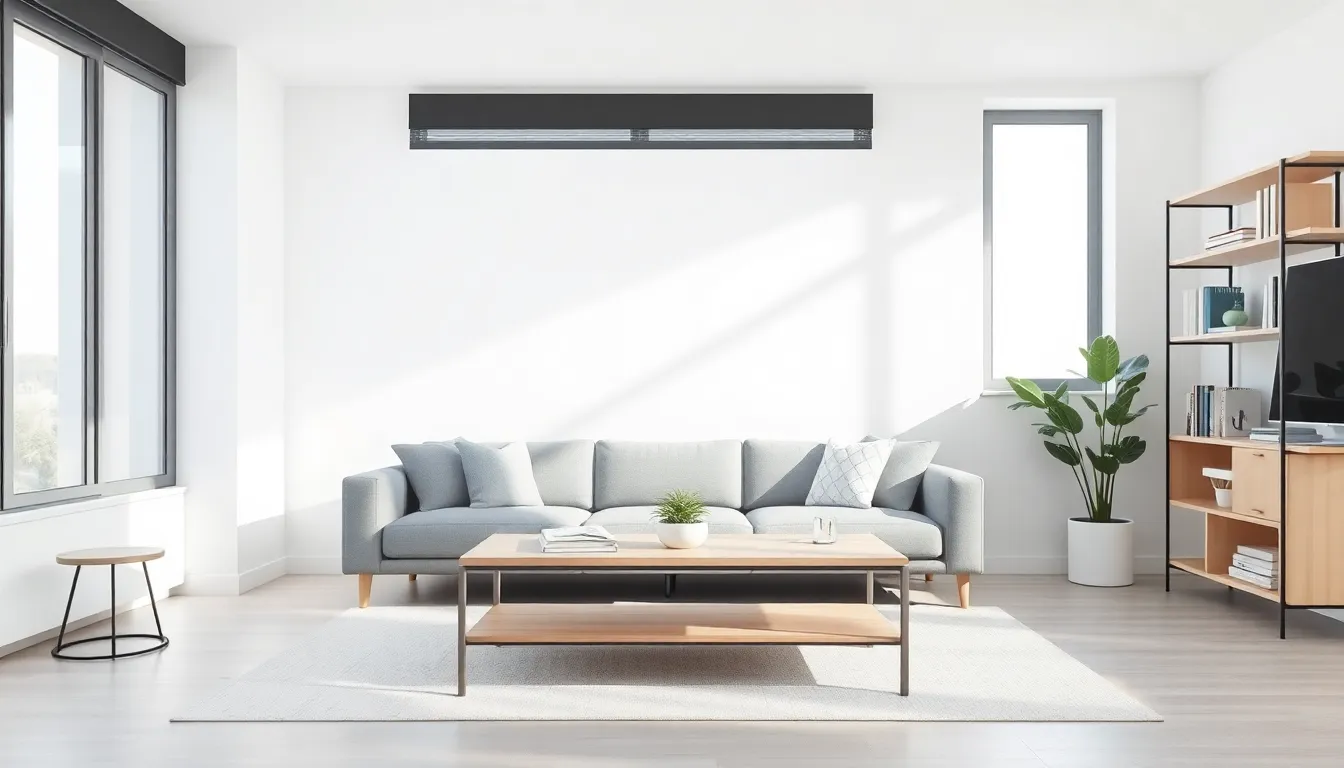Table of Contents
ToggleImagine stepping into a living room that feels like a breath of fresh air. A minimalist modern living room isn’t just a space; it’s a sanctuary where simplicity reigns and clutter takes a permanent vacation. With clean lines and a neutral palette, this design style invites serenity and sophistication, making it the perfect backdrop for both relaxation and entertaining.
What Is a Minimalist Modern Living Room?
A minimalist modern living room represents a sophisticated space that embraces simplicity. It features clean lines, open spaces, and minimal clutter, creating an atmosphere of tranquility. Neutral color palettes, including whites, grays, and soft earth tones, dominate the design, enhancing the feel of openness. Furniture choices often include streamlined pieces that prioritize function without sacrificing style.
Natural light plays a significant role in this design aesthetic. Large windows and glass doors help brighten the room, further promoting a spacious feel. Decorative items remain few, ensuring that each selected piece holds importance and contributes to the overall ambiance.
Textures add warmth and interest in a minimalist setting. Soft fabrics, such as linen or wool, contrast with sleek surfaces like glass and metal. Elements like wood also introduce a touch of nature to the space.
Layering becomes essential for creating depth and comfort. Rugs can define areas within the room, while cushions provide a pop of color or softness. Plants contribute life, enhancing the room’s connection to nature.
While functionality is crucial, aesthetics still matter. Artwork can serve as a focal point, yet it remains understated. Each element is carefully chosen to reinforce a sense of peace and simplicity in the living area.
Overall, a minimalist modern living room emphasizes the beauty of less. By focusing on essential pieces, the design fosters a serene environment ideal for relaxation and socialization.
Key Characteristics of Minimalist Modern Design

Minimalist modern design embodies simplicity through key characteristics that enhance the living space. These elements contribute to the overall aesthetic and functionality.
Simplified Furniture Choices
Simplified furniture choices define minimalist modern living rooms. Streamlined sofas and chairs maintain clean lines, avoiding excessive ornamentation. Each piece emphasizes function, often featuring multifunctional designs like storage ottomans or modular sofas. Essential furniture, rather than numerous items, creates an open feel. Space remains uncluttered, promoting a peaceful atmosphere conducive to relaxation and social interaction. Selecting quality over quantity ensures durability and a timeless appeal.
Neutral Color Palettes
Neutral color palettes play a significant role in minimalist modern design. Soft whites, grays, and earth tones create a calming environment that fosters serenity. These hues enhance natural light, making spaces appear larger and brighter. Accents or subtle variations can add depth, ensuring the design avoids monotony. Choosing a cohesive color scheme supports the minimalist ethos, allowing for a seamless flow throughout the room. A well-executed palette balances simplicity with sophistication.
Functional Decor Elements
Functional decor elements elevate minimalist modern living rooms. Essential decorative items blend art and utility, such as stylish shelving that displays select books or plants. Every piece serves a distinct purpose, contributing to the overall aesthetic without overwhelming the space. Textiles like throw pillows or blankets add warmth while remaining functional. Incorporating natural materials further aligns with the minimalist vision, emphasizing both beauty and practicality. Thoughtful decor selections create an inviting atmosphere celebrated for its simplicity.
Tips for Creating a Minimalist Modern Living Room
Creating a minimalist modern living room involves intentional choices that emphasize simplicity and functionality. Thoughtful selections can result in a serene and inviting space.
Choosing the Right Furniture
Select furniture that embodies clean lines and a streamlined silhouette. Emphasizing functionality, multifunctional pieces serve dual purposes, reducing the need for additional items. Opt for low-profile sofas and chairs to maintain an open feel. Incorporate natural materials like wood or metal, enhancing warmth and texture. Pieces should invite a sense of calm, devoid of excessive ornamentation.
Smart Space Planning
Plan the layout to promote openness and flow. Position furniture to facilitate conversation while allowing for easy movement around the room. Utilize area rugs to define spaces without creating barriers. Consider incorporating built-in shelving for storage, keeping surfaces free of clutter. By arranging items thoughtfully, the living room maintains a spacious atmosphere, fostering relaxation and connection.
Incorporating Natural Light
Maximize natural light through large windows and glass doors, enhancing the room’s airy feel. Minimize heavy curtains; sheer fabrics allow light to filter in while providing privacy. Reflective surfaces, like mirrors, amplify brightness by bouncing light around the room. Strategically placing furniture further away from windows avoids blocking sunlight. Prioritizing natural light promotes a tranquil and uplifting environment.
Common Mistakes to Avoid
Focusing too much on aesthetics can undermine the functionality of a minimalist modern living room. Prioritizing style over purpose leads to clutter and chaos, which contradicts minimalist principles. Neglecting natural light diminishes the serene atmosphere; ample windows and light fabrics enhance openness.
Relying on too many decorative items adds unnecessary distractions. Each decorative piece should serve a purpose; otherwise, it clutter the visual space. Forgoing multifunctional furniture limits usability. Selecting pieces that serve dual roles maximizes space and maintains minimalism.
Overlooking texture results in a flat environment. Incorporating various textures, such as woven fabrics and wood accents, adds warmth and interest. Prioritizing monochrome palettes can also limit visual appeal. Using subtle color variations creates depth while maintaining a calm atmosphere.
Ignoring floor plans might disrupt the flow of conversation and movement within the room. Thoughtful arrangement promotes easy interaction and enhances the minimalist design. Underestimating the impact of lighting can nightfall the aesthetic; layered lighting from various sources enhances atmosphere and functionality.
Forgetting about comfort while focusing exclusively on design leads to an uninspiring setting. Opting for comfortable seating encourages relaxation and enjoyment. Finally, dismissing personal style can compromise the space’s character. Including personal touches that align with minimalist aesthetics expresses individuality while keeping the environment cohesive.
Embracing a minimalist modern living room transforms any space into a tranquil oasis. By prioritizing simplicity and functionality, individuals can create an inviting atmosphere that promotes relaxation and connection. Thoughtful furniture choices and a neutral color palette enhance the sense of openness while allowing natural light to play a vital role in the overall ambiance.
Incorporating textures and subtle color variations adds warmth and depth, making the space feel both stylish and comfortable. Ultimately, a minimalist approach doesn’t mean sacrificing personality; it encourages the inclusion of meaningful decor that aligns with one’s individual style. This balance of aesthetics and practicality results in a harmonious living area that serves as a perfect backdrop for everyday life.




